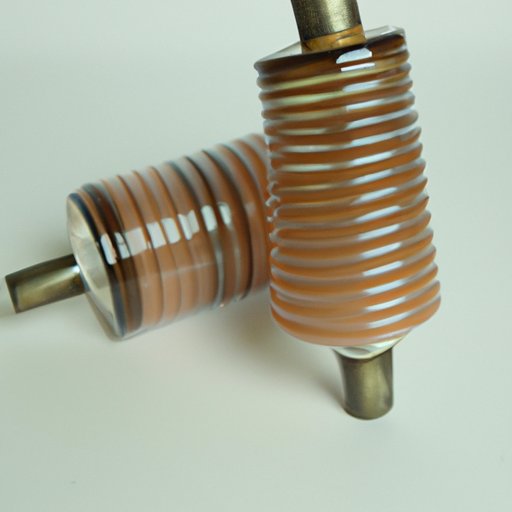Introduction
An insulator is a material used to reduce the flow of heat, electricity, or sound. They are essential components in a wide range of applications, from home appliances to industrial settings. In this article, we’ll explore what an insulator is in science, the physics behind insulators, different types of insulators, how they are used in everyday life, their role in the workplace, and their impact on the environment.
The Physics Behind Insulators
Insulators work by preventing the transfer of energy or sound. This is achieved through a number of physical processes. For example, in the case of electrical insulators, the electrons within the material are tightly bound so that they cannot move freely. This prevents any electrical current from flowing through the material. Similarly, thermal insulators are able to reduce the flow of heat due to the fact that they have very low thermal conductivity.
There are a number of common materials used as insulators, including glass, rubber, plastic, and air. These materials are all excellent at preventing the flow of energy or sound and are used in a variety of applications. For example, glass is commonly used as an electrical insulator, while rubber is often used as an acoustic insulator.
Different Types of Insulators
Insulators can be broadly categorized into three main types: electrical insulators, thermal insulators, and acoustic insulators. Each type of insulator has its own unique properties and is used for different applications.
Electrical Insulators
Electrical insulators are materials that do not allow electric currents to pass through them. These materials are commonly used in electrical wiring and in the construction of electrical devices. Some examples of common electrical insulators include glass, rubber, and plastic.
Thermal Insulators
Thermal insulators are materials that reduce the flow of heat. These materials are often used in the construction of buildings, as well as for insulation in home appliances such as refrigerators and water heaters. Common thermal insulators include fiberglass, foam, and cellulose.
Acoustic Insulators
Acoustic insulators are materials that reduce the transmission of sound. These materials are often used to reduce noise in industrial settings, as well as in the construction of soundproof rooms. Common acoustic insulators include foam, rubber, and cork.

How Insulators are Used in Everyday Life
Insulators are used in a wide range of everyday applications. Here are some of the most common uses:
Uses in Home Appliances
Insulators are used in a variety of home appliances, including refrigerators, water heaters, ovens, and washing machines. They help to keep the temperature inside the appliance consistent and prevent energy from being wasted. Additionally, acoustic insulators can be used to reduce noise from these appliances.
Uses in Construction and Renovation
Insulators are also used in the construction and renovation of homes and other buildings. Thermal insulators are used to keep buildings warm in winter and cool in summer, while acoustic insulators can be used to reduce noise from outside sources. Additionally, electrical insulators can be used to protect wires and other electrical components.
Uses in Industrial Settings
In industrial settings, insulators are used to protect workers from coming into contact with dangerous electrical currents and to reduce noise levels in the workplace. Electrical insulators, thermal insulators, and acoustic insulators are all used in industrial settings to ensure safety and comfort for workers.
Insulators in the Workplace
Insulators are essential components in the workplace. They can provide a number of benefits, including improved safety, increased productivity, and reduced noise levels. Here are some of the most common types of workplace insulation:
Benefits of Using Insulators in the Workplace
Using insulators in the workplace can provide a number of benefits. They can help to improve safety by reducing the risk of electrocution or fires, as well as reducing noise levels which can help to improve worker concentration and productivity. Additionally, using insulators can help to reduce energy costs by keeping temperatures in the workplace consistent.
Common Types of Workplace Insulation
The most common types of workplace insulation are electrical insulators, thermal insulators, and acoustic insulators. Electrical insulators are used to protect workers from coming into contact with dangerous electrical currents, while thermal insulators are used to keep temperatures in the workplace consistent. Acoustic insulators are used to reduce noise levels in the workplace.
The Impact of Insulators on the Environment
Insulators can have both positive and negative impacts on the environment. On the one hand, using insulators can help to reduce energy consumption, which can lead to lower carbon emissions. Additionally, many insulating materials are made from natural materials, such as cotton, wool, and wood, which can be easily recycled or composted.
On the other hand, some insulating materials can have a negative environmental impact. For example, some types of insulation contain chemicals that can be harmful to the environment if released into the atmosphere. Additionally, some insulating materials, such as foam, can take a long time to decompose once disposed of.
Conclusion
Insulators are essential components in a wide range of applications, from home appliances to industrial settings. They work by preventing the transfer of energy or sound, and are available in a variety of forms, including electrical, thermal, and acoustic insulators. Insulators can provide a number of benefits, including improved safety, increased productivity, and reduced energy costs. However, they can also have a negative environmental impact if not used responsibly. Overall, insulators are an important part of science, and their use should be carefully considered for each individual application.
(Note: Is this article not meeting your expectations? Do you have knowledge or insights to share? Unlock new opportunities and expand your reach by joining our authors team. Click Registration to join us and share your expertise with our readers.)
